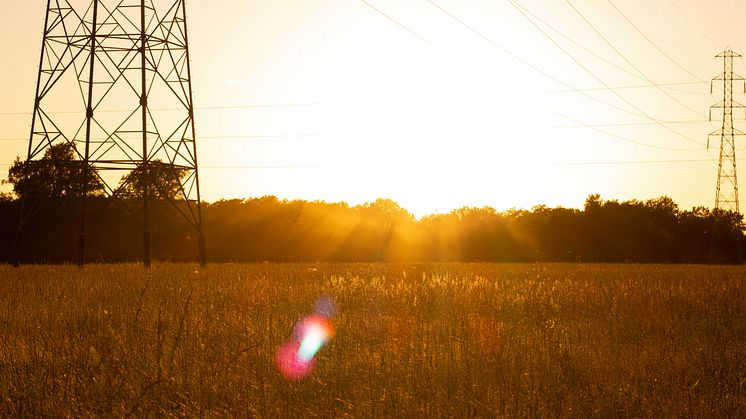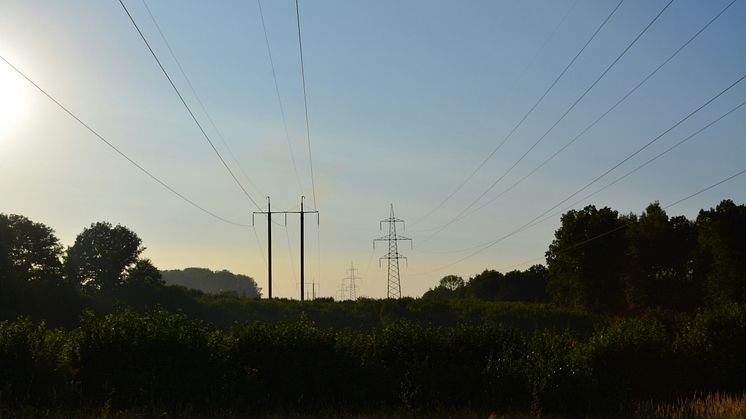
Blog post -
2025: The Year of Solar Storms – How AI and Digital Monitoring Can Safeguard Our Power Grids
As solar activity reaches its peak in 2025, the risk of geomagnetic storms that could knock out parts of our electricity grid increases. Combined with extreme weather, energy infrastructure faces new challenges. However, by digitalising transformer stations and investing in predictive maintenance, we can make electricity grids more resilient than ever before.
A New Type of Threat to the Grid
The electricity grid has traditionally been built to handle mechanical and electrical stresses, but global climate patterns and the sun's cyclical activity are changing the rules of the game. During 2025, the sun reaches its solar maximum, increasing the likelihood of powerful solar storms.
When these reach Earth, they can induce so-called geomagnetically induced currents (GIC) which, in the worst case, can knock out transformer stations, overheat cables, and cause widespread power outages.
Solar storms are not a theoretical future threat – they have already affected electricity grids in both Canada and Sweden. A well-known example is Quebec in 1989, where a powerful solar storm knocked out the entire province's electricity grid within minutes, leaving six million people without power. In Malmö in 2003, a solar storm caused protection systems to trip, leading to power cuts for tens of thousands of households.
During a new powerful solar storm – which researchers believe is likely in the near future, particularly during the solar maximum we find ourselves in during 2025 – today's electricity grids risk being subjected to overloads, voltage instability, and damage to sensitive equipment.
With a growing share of decentralised and weather-dependent electricity generation, the grid is also becoming more complex and vulnerable. This places higher demands on remote monitoring, predictive maintenance, and rapid decision-making when disturbances occur – to protect both the grid and the societal functions it supports.
Digitalisation as Defence
To meet these new risks requires a paradigm shift in how we maintain and monitor our electrical infrastructure.
Digitally monitored transformer stations provide the ability to:
- Remotely monitor conditions in real-time – temperature, humidity, vibrations, oil quality, etc.
- Identify trends and anomalies using AI and machine learning
- Predict failures before they occur and plan maintenance proactively
- React more quickly to incidents, with the possibility of remote disconnection or load redistribution
Predictive maintenance thus becomes not only a way to reduce downtime, but also a strategic line of defence against climate and space weather-related threats.
The Grid Must Become Smart – and Resilient
A modern electricity grid must not only be efficient, but also resilient. This involves:
- Identifying and strengthening vulnerable nodes
- Integrating external risk factors into planning, such as solar storm forecasts
- Working with digital twins to simulate scenarios
- Ensuring redundancy and capacity at critical points
Through digitalisation, remote monitoring, and data analysis, we create conditions for an electricity grid that not only survives future trials but also evolves with them.
The Future is Predictable – If We Listen to the Data
With the right sensors, data, and analysis, we can see patterns that were previously impossible to detect. The subtle changes that precede a transformer failure can now be identified long before critical levels are reached. This means that maintenance efforts can be planned strategically, often during periods of lower load, which both saves costs and prevents outages.
Ahead of a solar maximum like that in 2025, digitalisation becomes particularly valuable. By linking space weather data from organisations such as NOAA and ESA to monitoring systems for transformer stations, energy companies can prepare specifically for approaching solar storms. Sensors can then be directed towards precisely those parameters that indicate GIC impact, and additional measures can be taken to protect particularly exposed parts of the grid.
The energy companies investing in digital resilience today are not only building protection against individual incidents – they are also creating infrastructure that can adapt, learn, and become stronger over time. Every solar storm, every extreme weather event becomes an opportunity to gather data, refine algorithms, and improve protective measures.
2025 will be a stress test for our energy systems – but also an opportunity to demonstrate the power of modern technology and smart maintenance. By focusing on digitalisation and predictive maintenance, the energy sector now has the chance to transform potential threats into actual opportunities for innovation and improvement.





